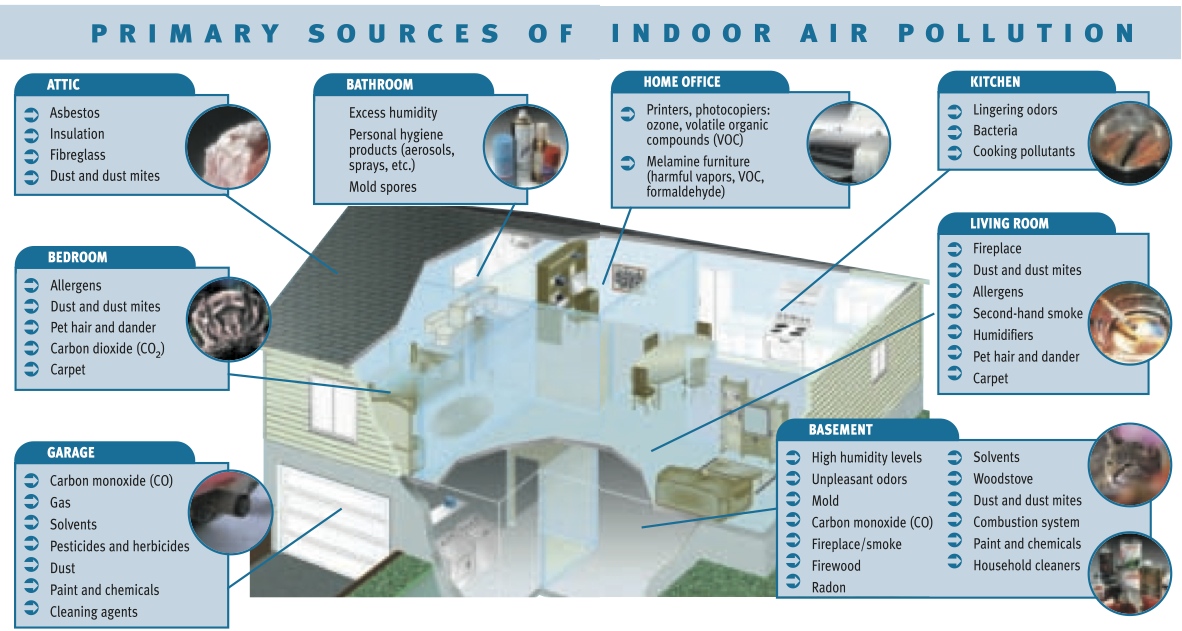Understanding and Managing Sick Building Syndrome
Sick Building Syndrome (SBS) represents a significant concern for building managers, directly impacting employee health, productivity, and overall business operations. Characterized by a range of symptoms that occupants experience within a specific building or area thereof, SBS challenges the conventional understanding of workplace wellness.
The term “sick building syndrome” (SBS) is used to describe situations in which building occupants experience acute health and comfort effects that appear to be linked to time spent in a building, but no specific illness or cause can be identified.
– EPA Indoor Air Facts No. 4
Its implications stretch beyond individual health concerns, influencing business credibility and environmental responsibility perceptions. This guide delves into the essential aspects of SBS, equipping building managers in Austin with the knowledge to identify, prevent, and manage this syndrome effectively, thereby fostering a healthier, more productive work environment.
What is Sick Building Syndrome?
Sick Building Syndrome encompasses various nonspecific symptoms that building occupants experience, symptoms that typically improve upon leaving the building. Distinct from Building Related Illness (BRI), which can be traced to specific pollutants or pathogens, SBS symptoms are more varied and less easily pinpointed to a singular cause. Statistics reveal that many commercial buildings nationwide report issues consistent with SBS, highlighting the urgency for building managers to address indoor environmental quality proactively.

Symptoms of Sick Building Syndrome
Occupants in buildings affected by SBS may report diverse symptoms, including headaches, dizziness, nausea, eye, nose, or throat irritation, dry cough, itchy skin, and difficulty concentrating. Notably, these symptoms typically alleviate after leaving the premises, underscoring the relationship between the building environment and occupant health. Recognizing these symptoms early is crucial for timely intervention.
How to Mitigate Sick Building Syndrome
Once symptoms of SBS are identified, taking immediate steps to mitigate its impact is crucial. Here are effective strategies for addressing SBS:
- Conduct a Comprehensive Environmental Assessment:
- Hire professionals to evaluate air quality, identify pollutant sources, and recommend corrective actions.
- Improve Air Filtration and Purification:
- Upgrade HVAC filters to higher efficiency levels to better trap contaminants.
- Install localized air purifiers in areas where air quality concerns persist.
- Address Specific Contaminant Sources:
- Remove or replace materials and equipment identified as significant sources of pollutants.
- Repair leaks and address water damage promptly to prevent mold and mildew growth.
- Adjust Work Practices:
- Modify activities contributing to poor indoor air quality, such as relocating printers to well-ventilated areas.
- Encourage employees to report air quality concerns and symptoms of discomfort.
- Enhance Cleaning Protocols:
- Increase the frequency of cleaning, focusing on thorough disinfection of surfaces.
- Use effective cleaning products yet minimize additional chemical exposure.
- Educate and Communicate:
- Inform employees about the steps being taken to improve air quality and reduce SBS risks.
- Establish clear channels for reporting symptoms and concerns related to SBS.
- Monitor and Adjust:
- Continuously monitor the effectiveness of implemented measures.
- Be prepared to adjust strategies based on feedback and new information.
Causes of Sick Building Syndrome
The causes of SBS are multifaceted, involving factors such as inadequate ventilation, chemical and biological contaminants from both indoor and outdoor sources, and the exacerbation of these issues by specific building activities. For instance, adhesives, carpeting, and even office equipment can release harmful compounds, while outdoor pollutants like vehicle exhaust can infiltrate indoor spaces. Additionally, accumulating biological contaminants, including molds and bacteria, can contribute to SBS. Understanding these potential sources is the first step in mitigating their impact.
Diagnosing Sick Building Syndrome
Identifying SBS within a building involves a combination of environmental assessments and occupant surveys. Building managers should seek professional evaluations to measure indoor air quality and identify potential hazards. Concurrently, surveying occupants for symptoms can help correlate health complaints with environmental conditions, guiding targeted interventions.
Preventing and Managing SBS
Effective management of SBS centers on improving indoor air quality through measures such as enhancing ventilation, regular maintenance of HVAC systems, and adopting air purifiers or dehumidifiers. Choosing low-emitting materials during renovations or new constructions can also mitigate chemical pollutants. Additionally, routine cleaning and maintenance are vital for controlling biological contaminants, while staff training on proper waste disposal and chemical storage practices can further reduce risks.
How to Prevent Sick Building Syndrome in Your Office
Preventing Sick Building Syndrome involves proactively maintaining indoor air quality and ensuring a healthy work environment. Here are key strategies:
- Enhance Ventilation:
- Increase the intake of outdoor air to dilute indoor pollutants.
- Ensure that ventilation systems are designed and functioning to meet the specific needs of your building’s occupancy and activities.
- Regular Maintenance of HVAC Systems:
- Schedule regular inspections and maintenance of heating, ventilation, and air conditioning (HVAC) systems to prevent the circulation of dust and contaminants.
- Replace filters as recommended by manufacturers to ensure optimal air quality.
- Use Air Purifiers and Dehumidifiers:
- Place air purifiers in areas prone to poor air quality to remove contaminants.
- Use dehumidifiers in damp areas to prevent mold growth.
- Select Low-Emitting Materials and Products:
- Choose paints, carpets, furniture, and building materials emitting less volatile organic compounds (VOCs).
- Opt for office supplies and cleaning products that are environmentally friendly and low in chemicals.
- Implement Regular Cleaning and Maintenance:
- Establish a routine cleaning schedule to remove dust, allergens, and potential irritants.
- Focus on high-touch areas like doorknobs, light switches, and common surfaces for regular disinfection.
- Minimize Chemical Pollutants:
- Store chemicals in sealed containers and well-ventilated areas.
- Avoid using pesticides and air fresheners that can contribute to indoor air pollution.
- Design Considerations:
- Incorporate natural light and green spaces to improve air quality and overall well-being.
- Design spaces to facilitate easy cleaning and maintenance, reducing dust and contaminant accumulation.
Implementing these preventive and mitigative strategies can significantly reduce the incidence of Sick Building Syndrome, creating a healthier and more productive office environment.
Case Studies/Success Stories
Exploring case studies where strategic interventions have successfully mitigated SBS can offer valuable insights and practical advice for building managers. These theoretical narratives demonstrate the feasibility of improving indoor environmental quality and highlight the positive outcomes on occupant health and business operations. Learning from these examples empowers building managers to implement effective strategies within their facilities.
Case Study 1: High-Rise Corporate Office in Austin, Texas
Background: Employees at a modern high-rise corporate office in downtown Austin persistently complained of headaches, eye irritation, and fatigue, symptoms indicative of Sick Building Syndrome. The building management team initiated an investigation to identify and address the root causes.
Interventions:
- Conducted a comprehensive environmental assessment by a professional indoor air quality (IAQ) firm.
- Upgraded the HVAC system to improve air filtration and increase fresh air exchange.
- Replaced traditional cleaning products with green, low-VOC alternatives.
- We installed plants throughout the office to purify the air naturally.
Outcomes: Within three months of implementing these changes, employee complaints decreased by 75%. Follow-up surveys indicated a significant improvement in overall employee satisfaction and productivity. The company also reported decreased sick leave usage due to the improved office environment.
Case Study 2: Historic Bank Building Retrofit
Background: A historic bank building, repurposed as office space, struggled with poor ventilation and musty odors, contributing to frequent respiratory complaints from occupants. Recognizing the need for intervention, the building’s property management sought solutions that balanced historic preservation with modern environmental standards.
Interventions:
- Sealed and repaired windows to reduce drafts and outdoor pollution infiltration while maintaining the building’s historical integrity.
- Implemented a zoned HVAC upgrade to enhance ventilation without compromising the building’s aesthetic and structural elements.
- We initiated a deep-cleaning regime focused on mold and mildew remediation, particularly in the building’s older, less ventilated parts.
Outcomes: Post-intervention, the building saw a marked improvement in air quality readings, with a 60% reduction in tenant-reported health complaints. The success of this project was featured in a local business journal, highlighting the balance of heritage conservation with health and safety considerations in building management.
Conclusion
Recognizing and addressing Sick Building Syndrome is paramount for ensuring the health and productivity of building occupants. By implementing targeted strategies to improve indoor air quality, building managers can significantly reduce the incidence of SBS, thereby enhancing workplace wellness and reinforcing their commitment to providing safe, healthy environments. Proactive management of indoor environmental quality is a key pillar in maintaining physical health and organizational vitality.
Austin building managers are encouraged to regularly review their buildings’ environmental conditions and remain vigilant for signs of Sick Building Syndrome. Consider partnering with a professional cleaning and environmental management service for expert assessments and tailored interventions. Taking these steps will ensure your office remains a healthy, productive space for all occupants.

